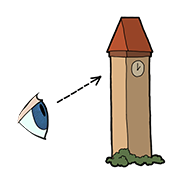Spatial awareness means being aware of the positions of left, right, front, back, top, bottom and correct determination of direction.
Some individuals with dyslexia (it does not apply to everyone, though) experience some troubles in this area. It is difficult for them to quickly determine where is right and where is left and when they find themselves in a new environment, they do not remember how they got there, are not able to find the way there on their own, etc. They often happen to get lost, they are late because they did not realize they should have taken a turn, they are unable to find the same way back, they do not remember where they parked their car, etc. However, we also need spatial awareness for orientation in a text on a page, so that we realize that we read from left to right, from top to bottom and in which direction we write. Spatial awareness can also be trained very well. Even people who have “an absolute nonsense of direction” can learn how to navigate the world, but it requires a bit of effort, diligence, training and targeted thinking about the space around them. If you resign and just proclaim that you have no sense of direction and do not know how to orient yourself, it is likely to stay that way. Among the simplest procedures at the beginning of training can be a deliberate search for clues (i.e. landmarks and places in the area) that would allow you to track which way you are going and what surrounds you. However you have to consciously direct your attention! Another useful trick is to realize where people have their heart when we look at them. Almost every one of us can recognize it, we just “see” it. And this is where their left side is, from which we can deduce where the right side is, and thus also where is left, right, front and behind of that person.

Tip: When you go somewhere, always pay attention to landmarks.